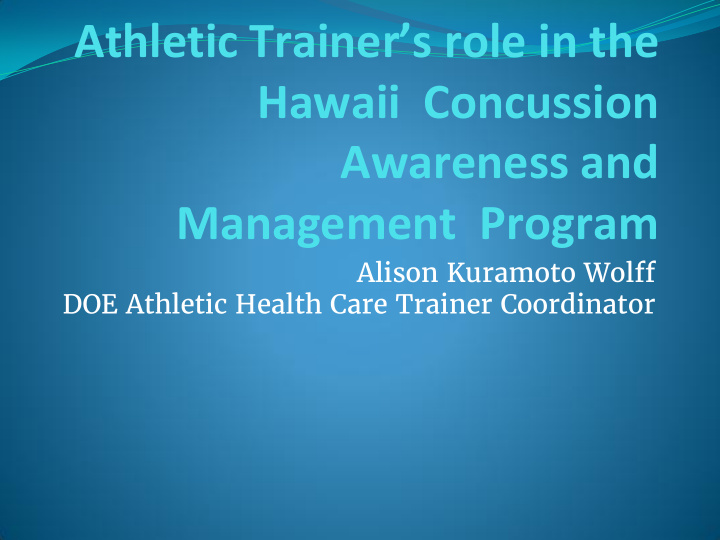



Athletic Trainer’s role in the Hawaii Concussion Awareness and Management Program Alison Kuramoto Wolff DOE Athletic Health Care Trainer Coordinator
Hawaii Concussion Awareness & Management Program ● New Concussion Law, ACT 264, Signed July 12, 2016 ● Funding for cognitive testing ● Concussion Law, Act 197, Signed July 2012 Education of parents, students, school staff & 1. administrators & sports officials New law includes education to middle school youth 1. athletic activities (11 to under 19 years old) 2. Annual training of coaches & athletic trainers Mandatory removal of students suspected of 3. sustaining a concussion 4. Need for Physician clearance to return to play 5. Stepwise return to play supervised by ATC
Concussion Management Program ● State wide program, includes all DOE and private high schools ● This program was designed for the health and safety of all student athletes.
How many concussion do we have in the DOE? 500 450 400 350 300 250 2010-11 2011-12 200 2012-13 150 2013-14 4 5 100 50 0
Neurocognitive Testing School Year # of Baselines # of Concussions 2010 - 11 4,683 446 2011 - 12 10,113 895 2012 - 13 10,496 1,140 2013 - 14 10,012 1,370 2014 - 15 9,451 1,008
Number of Concussion by Sport SY 2010-14 500 1 450 400 350 300 250 2010-11 2011-12 200 2012-13 2 150 2013-14 3 4 5 100 50 0
Number of Days Missed Report from August 1, 2011 to July 31, 2014 Days Missed MEAN SD August 1, 2013 – July 31, 2014 26.15 25.17 (n=1370) August 1, 2012 - July 31, 2013 26.2 18.98 (n=1140) August 1, 2011 - July 31, 2012 23.5 16.5 (n=845)
Starts with Baseline Assessments (prior to injury) ● All incoming 9th and 11th grade student athletes participating in collision and contact sports will be administered the following baseline assessments ● Graded Symptom Check list (GSC) ● Cognitive status assessment using either Immediate Post-Concussion Assessment Test or Standardized Assessment of Concussion test
ImPACT
ImPACT
Team Approach to manage concussions
Post-Concussion Assessments ● Should a student athlete sustain a head trauma the Athletic Trainer will: ● Immediately remove athlete from game / practice ● Conduct clinical evaluation ● Decide immediate referral to physician and/or activate Emergency Medical System or Delayed Referral ● Athletic trainer will provide student athlete or parent/guardian with two forms: ● GSC List for Concussed Athletes ● Medical Referral Form For Concussed Athletes
Forms
What are the steps for my athlete to get back on the field/court? ● Physician clearance to start return to play protocol ● Return to baseline or normative values on ImPACT, and Graded Symptom Check list
Exercise portion of the RTP
How long does a student take to recover? ● Student athletes average 26 days to recover ● It takes an average of 12 days to go from step 1 to step 3. Light Complete Return to Exercise Cognitive School Rest Full Time Step 1 Step 2 Step 3
Keys to Recovery ● Resting the brain & getting good sleep ● No additional forces to head/ brain ● Managing/ facilitating physiological recovery ● Avoid activities that produce symptoms ● Not over-exerting body or brain Ways to over-exert ● Physical ● Emotional ● Cognitive! (concentration, learning, memory)
Cognitive Rest is essential ● Cognitive rest can include: ● Limiting work done at school ● Limiting time watching tv, use of cell phone and computers, video games and even reading.
Physical Rest ● This includes NOT only NOT participating in the athlete’s sport but also additional recreational activities such as skateboarding, surfing, jogging and anything that causes physical exertion.
What should a coach do if his/her student athlete has a concussion? ● If emergency, follow your school’s EAP ● Coaches need to report concussion to: ● Athletic Trainers ● Parents
What should parents do if they think their child has concussion? ● Communicate with ● Physician ● Coach ● Athletic Trainer ● School Administration / Counselors
What to watch for after a concussion ● Increased problems paying attention or concentrating ● Increased problems remembering or leaning new information ● Longer time needed to complete tasks or assignments ● Difficulty organizing tasks ● Inappropriate or impulsive behavior ● Greater irritability ● Less ability to cope with stress or more emotional
What is my take home message? ● We need to work as a team to manage concussions. ● Become educated about concussions ● Change the way we view a concussion ● It’s not a “Ding” it’s a serious brain injury
Centers of Disease Control & Prevention (CDC) ● www.cdc.gov/concussion/HeadsUp/high_scho ol.html ● www.cdc.gov/concussion/HeadsUp/youth.html ● www.cdc.gov/concusion/HeadsUp/schools.html ● www.cdc.gov/concussion/clinician.html
Recommend
More recommend